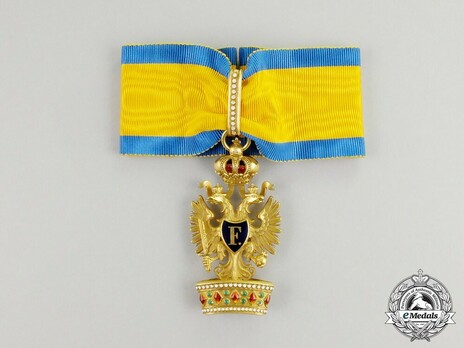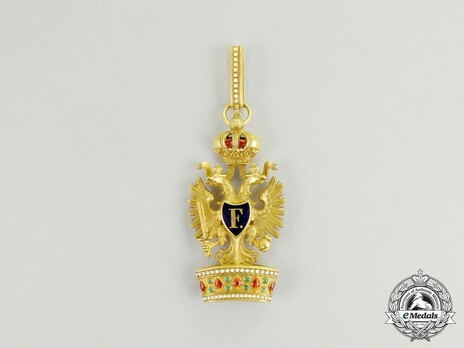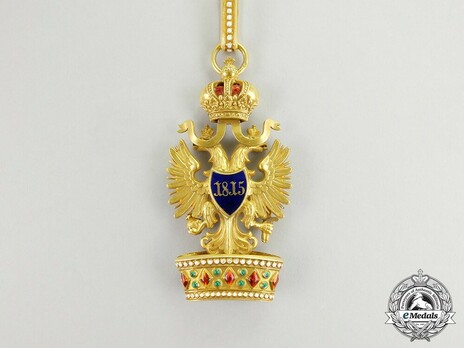Order of the Iron Crown, Type III, Civil Division, II Class (in Gold)
CATEGORY: Version
SKU: 01.AUT.0107.304.01.001
Estimated market value:



Estimated market value:
An Early Imperial Austrian Order of the Iron Crown in Gold; 2nd Class by Rothe, Wien
Neck badge Second Class, in Gold and enamels, marked on the ring AND below the crown obverse, "FR" (in square, for Rothe, Wien), along with Imperial Austrian Gemsenkopf mark (for 18 Kt. Gold); with iron crown embedded into jeweled crown; badge measures 33.4mm x 65.5mm (inclusive of its crown suspension), overall a superb quality badge without enamel imperfections, circa 1880 period manufacture ("FR" in square dates from that period), with full length of original neck ribbon, in extremely fine condition and very attractive.
The Order of the Iron Crown was originally established by Napoleon I on June 5, 1805, just a few days after his coronation as the King of Italy. This order was awarded for services to the crown in military, administration, arts and literature. There were to be 20 Grand Crosses (dignitaries), 100 Commanders (commandeurs) and 500 Knights (chevaliers), each with a specific number set aside to be awarded to French officers.
The insignia chosen was the French eagle with a stylized crown, along with the motto “Dieu me l’a donne, gare a qui y touchera” meaning “God gave it to me, heaven help him who touches it,” the phrase Napoleon is famous for after crowning himself king on May 26 earlier that year, just several months before the order’s induction. A portrait of Napoleon is in the center of the obverse medallion. The Grand Cross, worn on a neck ribbon, and Commanders were comprised of Gold whereas the Knights were made of silver. Recipients of the Order were allowed to call themselves Knights of the Order, and they were able to pass on their title to their heirs after proving an appropriate income level.
In 1806, a sash with three embroidered breast stars was added for the Grand Cross, to counteract the confusion of the Grand Cross originally being worn on the neck ribbon. Commanders were then given a rosette on the ribbon and knights ribbons remained plain. In 1809, the insignia was altered, with the inscription in Italian and small beads were added to the points of the crown. The order was dissolved in 1814, when the “Austrian” Kingdom of Lombardy-Venetia was founded in place of the French control. Throughout this first period of the decoration’s existence, a total of 1909 knights were awarded.
The Lombardo-Venetian Kingdom joined the Austrian Empire in 1814 and was under control of the Emperor of Austria. The Napoleonic order of the Iron Crown became the Austrian ‘imperial’ dynastic order. Regardless of this change of jurisdiction, King Louis XVIII stated that wearing the Iron Crown would still be permitted. Chancellor Prince Klemens Wenzel Metternich-Winneburg was appointed by the Emperor to create new statues for the order, during which time the members of the order were only allowed to wear the ribbon of the order. By January 1816, the new statues were approved by Emperor Franz I, and the order was officially restored on his birthday, February 12, 1816 as the “Austrian Imperial Order of the Iron Crown.”
The Austrian Imperial Order of the Iron Crown.
The order would be awarded solely by the Grand Master, to individuals who had proven their allegiance to the prince and state, had successfully promoted the wellbeing of the monarchy, or had made significant contributions to charitable institutions. The insignia was changed to fit the new rule and the circlet (also called a diadem) of the Bajuvaric-Landgobard Queen Theodolinde (ca. 570-627) was included, due to its connection to Monza and the ruler of the Lombard Kingdom. In place of the French eagle would be a golden double-headed eagle of Imperial Austria. The inscription would read “Avita et Aucta” meaning “Inherited and Augmented.” The obverse shield was to have an “F” and the reverse “1815.” The main colours were yellow, blue and white, representative of Lombardy-Venetian coat of arms. It was awarded in three classes.
Knights I Class were limited to 20 and the badge was worn on a sash from the right shoulder to the left hip, with a silver embroidered breast star in the middle. The I Class also included a Gold collar worn at ceremonial functions. Knights II Class, limited to 30, featured a slightly smaller badge worn around the neck on a wide ribbon. Knights III Class was even smaller and worn on the left side of the chest.
The first induction ceremony occurred on February 12, 1816. Members of the ‘old’ Napoleonic order were allowed to hand in their decoration and receive a ‘replacement’ order of the equivalent class. These Type I decorations were also called “de Remplacement.” There were very few differences between the replacement decorations and the new order. One was the either lack of or grainy quality of the blue enamel in the central shield and another was that the embroidered star of the Grand Cross was altered to omit the medallion’s device and instead held a laurel wreath. No privileges were associated with this replacement order until 1823 when economic difficulties inspired the Emperor to grant a pension to the remaining knights of the old order.
In 1838, Emperor Ferdinand I was crowned King of Lombardo-Venetian Kingdom in Milan of his own accord. At the same time, the appearance of the badge was altered. As of 1847, stars were to made of metal bodies instead of embroidered, much like the Order of Leopold. In 1860, military achievements were to be signified by a green enamelled laurel wreath and known as a war decoration. When knights received a higher class in peacetime, they were awarded a ‘war decoration of lower grade.’ For the II Class, this was identified with a laurel wreath applied on the obverse central shield. That same year, the surmounting crown was made convex and red enamelling was added to the central cap. In 1877, the I Class stars were to have faceted rays, matching all the other Austrian orders (even though it was implemented several years later).
Austria was a part of several wars throughout the Nineteenth century, resulting in the loss of both Lombardy (1859) and Venice (1866). When Italy was united, the “Order of the Italian Crown” was created by Victor Emanuel II, which kept the general motif of the circlet crown but changed the statutes and appearance it was very different. This development meant that the Austrian Order of the Iron Crown could not be awarded to Italians. Instead, substitute classes were awarded from other Austrian Orders. In replacement of the Knight II Class the ‘Komtur with star’ of the Franz Joseph Order, the I Class Order of Leopold was substituted for the I Class in 1901, and finally instead of the Knights III Class, the “officer’s Cross” of the Franz Joseph Order.
In 1908, the insignia was again revised to accommodate the new Austro-Hungarian uniforms. Kleindekorations “small decorations” were added. Grand Cross/ I Class awards were to be represented by a small star on the III Class decorations’ ribbon. If a war decoration was included, a laurel wreath would be included on both the III Class knight and on the small star. If a ‘war decoration of lower grade’ had its own decoration.
Even more changes were introduced during the First World War. Emperor Karl I added an Imperial Army and Navy Order, and also added swords to be awarded for courageous conduct in the face of an enemy. Knights III Class wore two swords applied to the ribbon, whereas the other classes had the swords applied directly to the decoration. The I and II Classes had gold-plated swords between the double-headed eagle and crown. The lower grade swords were comprised of an oxidised silver instead of gold. One year later, the small decoration for the II Class was added, in the form of a small iron crown applied to the ribbon.
Allowing II and III Class recipients to be awarded the order a second time was considered in 1918, and several ideas of how to distinguish this intermediate level were put forth. Eventually it came down to added a golden bar on the ribbon for the III Class, however this was very rarely done. It was only during the Heller Commission (1918-1922) that this was done.
The Knight II Class, Type I is slightly smaller than the Knight I Class. The crown is flat, the tail and body of the eagle are securely attached to the crown in ‘thick’ manner. Type II displays a hollow crown, with more tail feathers visible between the eagle and the crown. There are also white dots on the suspension ring. Type III features a red enamelled crown and more delicate feathers, often the work of C. F. Rothe.

Comments
Sign in to comment and reply.


Scroll Top